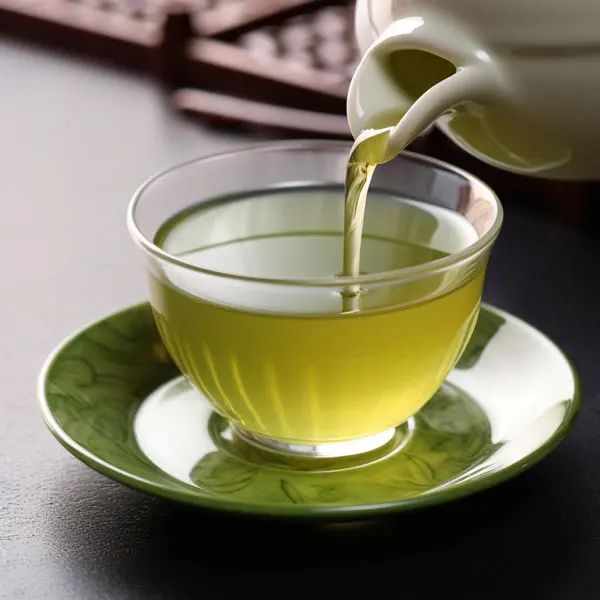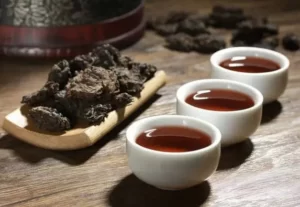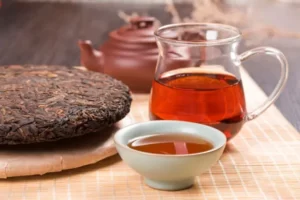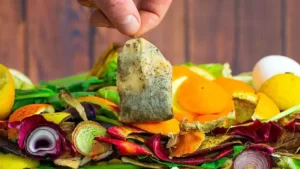Introduction
Welcome to our blog! Today, we will introduce you to 33 classic Yixing teapots that every beginner needs to know. By understanding the shapes and cultural history of Yixing teapots, as well as their makers, we aim to cultivate your ability to identify different types of teapot forms.
Yixing teapots are unique tea utensils from China with a history of several hundred years. They are renowned for their distinctive shapes and craftsmanship, with each shape having its own origins and cultural significance. In this blog, we will introduce you to some of the most classic Yixing teapots forms to help you understand their characteristics and uses.
If you’re interested, click here to learn about the design principles behind the teapot shape.
Additionally, we will also introduce you to some renowned Yixing teapot makers, allowing you to learn about their backgrounds and styles. These makers are known for their exceptional skills and innovations, and their works are widely collected and admired. By understanding the backgrounds and creations of these makers, you can better appreciate and choose Yixing teapots that suit you taste.
We hope this blog provides valuable information for beginners and helps you explore the world of Yixing teapots more effectively. Let’s get started!
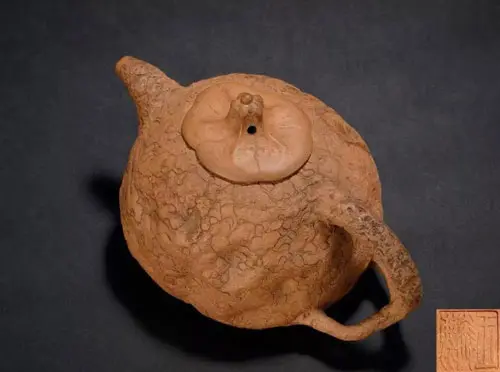
The Classic Yixing Teapots of the Ming Dynasty
1. Gong Chun Teapot(供春壶)
The Gong Chun teapot has a unique shape resembling a tree knot, with the lid crafted from a melon stalk. The entire body of the teapot is adorned with swirling textures, resembling gnarled knots on an old tree, while the handle is made to resemble branches and stems. Many renowned Yixing potters have replicated the Gong Chun teapot, including Huang Yulin and Jiang Zuchen from the Qing Dynasty.
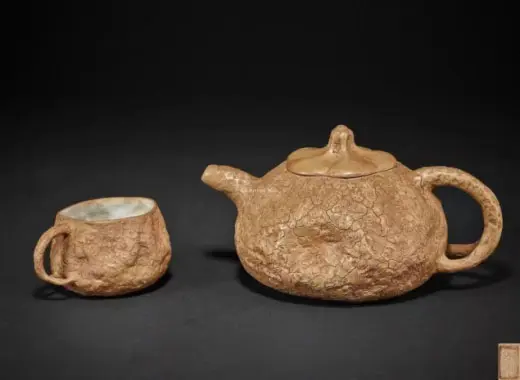
Representative Artisan: Gong Chun (approximately 1506-1566), a Ming Dynasty potter (1522-1566). Originally a servant of Wu Yishan, a Yixing scholar-official, Gong Chun later studied the art of crafting Yixing teapots under the guidance of monks at Jinsha Temple.
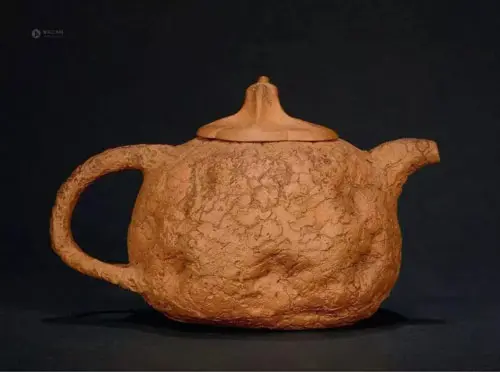
2. Narcissus Six-Petal Square Teapot(水仙花六瓣方壶)
The Narcissus Six-Petal Square Teapot displays a unique, elegant, and unadorned charm, embodying the beauty of Chinese historical culture. It is considered a typical classic Yixing teapots. This teapot features a six-petal design, with the six petals forming the opening, seamlessly aligned with the lid. The handle is delicately carved, and the veins extend downward, forming a concave indentation on the shoulder of the teapot, creating a captivating visual effect.
Representative Artisan: Shi Peng, a Yixing teapot artisan from the Ming Dynasty, also known as Shi Piao. He is the father of Shi Dabin and renowned for his simple and rustic style. Alongside Dong Han, Zhao Liang, and Yuan Chang, they are collectively referred to as the “Four Great Masters.”

3. Monk’s Cap Teapot(僧帽壶)
The Monk’s Cap Teapot is one of the ceramic teapot designs created during China’s Yuan Dynasty. Its name derives from the shape of the teapot spout, resembling a monk’s cap. The design features an upturned mouth, lower front, higher back, and a duckbill-shaped spout. The lid rests inside the mouth, showcasing a distinct ethnic style. The lower part of the teapot’s body is decorated with eight-petal patterns, representing lotus flowers or Buddhist symbols. The overall shape exudes a dignified and antique appeal, with a refined and serene charm.
Representative Artisan: Li Yangxin, also known as Maolin, was a Yixing teapot master during the Jiajing and Wanli periods of the Ming Dynasty. He hailed from Yixing, Jiangsu province. Following the “Four Great Masters” (Dong Han, Zhao Liang, Yuan Chang, and Shi Peng), Li Yangxin was another renowned teapot craftsman known for his rustic style. He excelled in creating small round-shaped teapots, often referred to as “exquisite treasures,” showcasing a combination of simplicity and elegance.

4. Round Knob Teapot(圆钮壶)
The Round Knob Teapot features a round body, a raised lid, a spherical knob on top, a short and forward-extending spout, and a naturally curved and hanging handle. This teapot immediately emanates the aura of masterful Yixing teapot craftsmanship, exuding an enchanting and delicate charm.
Representative Artisan: Li Zhongfang, a late Ming Dynasty potter from Yixing. He was the son of Li Maolin and a disciple of Shi Dabin. Combining family traditions with the teachings of his master, Li Zhongfang developed his unique style. He, along with Shi Dabin and Xu Youquan, are hailed as the “Three Great Masters of Teapot Craftsmanship.”
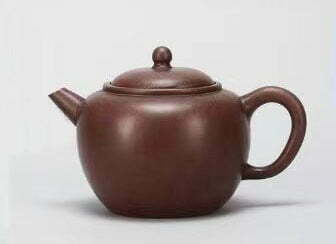
5. Pearl-shaped Teapot(圆珠壶)
The Pearl-shaped Teapot features a large spherical body and a small spherical knob as the lid, creating a harmonious correspondence. The spout gracefully extends forward, while the handle is convenient to hold, presenting a simple, smooth, and adorable design. When enjoying tea and appreciating the teapot, its lustrous and precious appearance adds to its appeal. On closer inspection, the teapot also bears a resemblance to the elegant shoulders of a beautiful woman.
Representative Artisan: Shao Wenyin, also known as Hengyu, lived between the seventh year of the Wanli period of the Ming Dynasty and the Shunzhi period of the Qing Dynasty. He was a disciple of Shi Dabin.
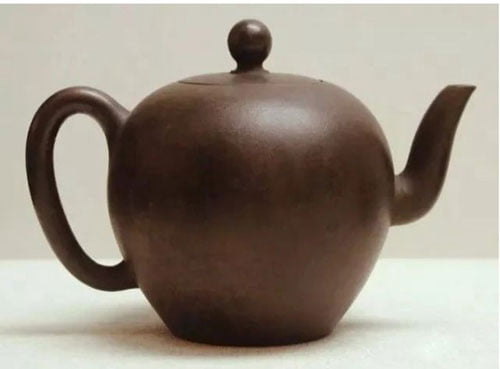
6. Tiliang Teapot(提梁壶)
The Tiliang Teapot from the Jiajing period of the Ming Dynasty was unearthed in 1965 from the tomb of Wu Jing, a eunuch of the Ming court, located outside the Zhonghua Gate in Nanjing. It is the earliest known purple clay teapot and shares similarities with some teapot designs from the Song and Tang dynasties, featuring a slightly curved spout.
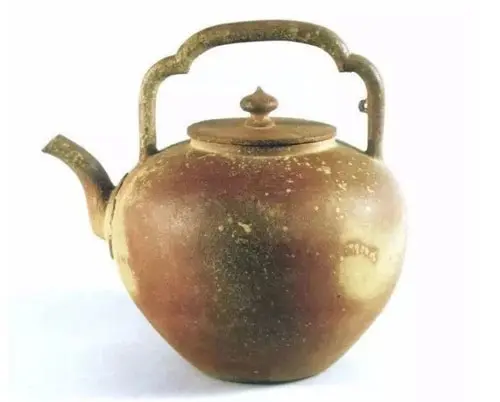
When observing the evolution of teapots, pay attention to the shape of the spout. The earliest purple clay teapot from the Song Dynasty had a slightly curved spout. In the Ming Dynasty, the curvature became even more pronounced.
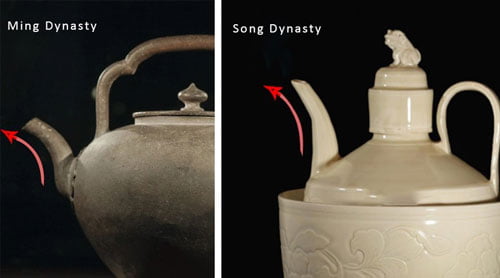
7. Auspicious Beast Teapot(瑞兽壶)
The Auspicious Beast Teapot has a peculiar shape, with the entire body resembling rising clouds and flowing water. The animal head emerges from one side, while the tail forms the handle, and the four square feet stabilize the base. The lid and body seamlessly merge, creating a unified and natural design. During the late Ming period, traditional “film covering(make clouds of mud and stick to the surface of the teapot)” techniques were used to create cloud-like decorations on teapots in the Yixing region.

Representative Artisan: Chen Zhongmei, born during the Wanli period of the Ming Dynasty, was originally a skilled teapot maker in Jingdezhen. He later moved to Yixing and became renowned for harmoniously combining porcelain craftsmanship with purple clay pottery, creating the “hollow carving” technique.
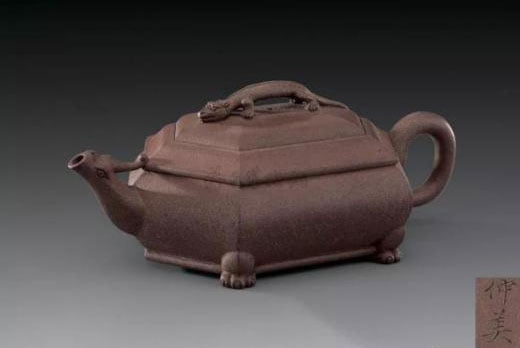
8. Rib Pattern Teapot(菱花壶)
The Rib Pattern Teapot is inspired by ancient water caltrop flower-shaped mirrors, symbolizing blooming flowers reflected in water. The lines extend from the center of the lid and base, forming neat and tight patterns. The knob, lid, body, and round feet correspond to blooming diamond flowers. The overall design is elegant, refined, and characterized by clear and radiant lines radiating from the center of the lid, creating a harmonious and distinct appearance.
Representative Artisan: Zhou Jishan, a master teapot maker from Yixing during the Tianqi and Chongzhen periods of the Ming Dynasty. He excelled in creating innovative tea sets and elegant artwork, displaying unique characteristics.

9. Crescent Moon Teapot(半月壶)
The Crescent Moon Teapot has an inverted bowl-shaped or hemispherical body, with a crescent-shaped profile. The spout can be curved or straight, and the handle is simple, usually accompanied by a small spherical or bridge-shaped knob at the top of the lid. It exudes a simple, stable, rigorous, and ancient beauty, showcasing its unique charm.
Representative Artisan: Chen Ziqi, a renowned purple clay teapot master from the late Ming Dynasty to the Kangxi period of the Qing Dynasty. His works often featured thin and delicate purple clay, showcasing exquisite craftsmanship.
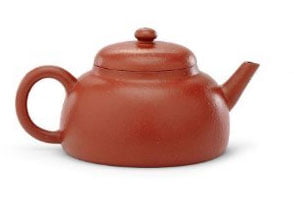
10. Sand-Coated Round Teapot(铺砂圆壶)
During the Ming Dynasty, most purple clay teapots were large in size, often featuring a ribbed body. The markings on the bottom were mostly carved on, and the use of seals did not become popular until the Qing Dynasty.
Representative Artisan: Hui Mengchen, estimated to have lived between the Tianqi period of the Ming Dynasty and the Kangxi period of the Qing Dynasty. He hailed from Jingxi and was a renowned teapot artist. His works were distinguished by their small size, with fewer medium-sized teapots and rare large-sized teapots. The larger teapots had a rustic and unadorned appearance, while the smaller ones exhibited exquisite craftsmanship.
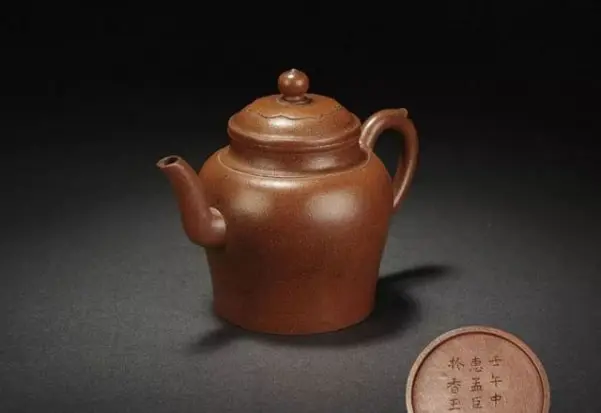
11. Sacred Peach Teapot(圣桃壶)
The Sacred Peach Teapot takes the form of a longevity peach, with a small peach serving as the lid knob, preserving the overall perfection of the vessel. The teapot body resembles a complete peach, while the handle is a slender and vigorous branch. The branches, leaves, flowers, and fruits convey a vibrant vitality, showcasing intricate and flawless craftsmanship and a delightful and imaginative design.
Representative Artisan: Sheng Si, said to be a late Ming Dynasty Taoist practitioner. With the surname Xiang, he was skilled in crafting peach-shaped cups that surpassed ordinary vessels. The flowers, leaves, branches, and fruits were all exquisite.
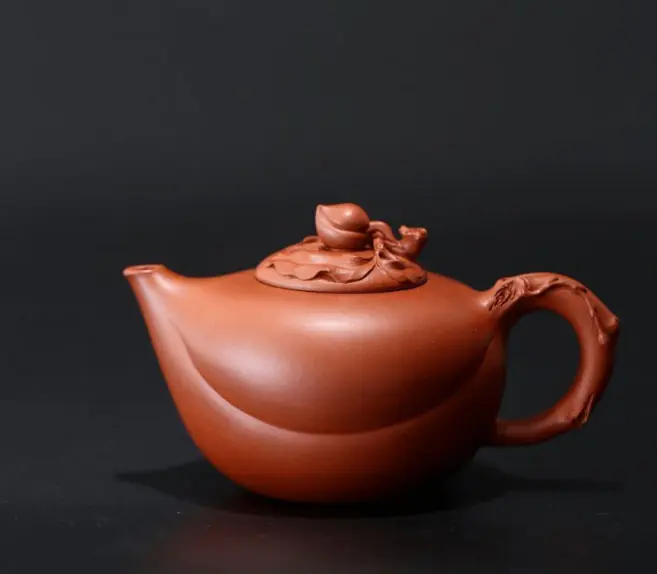
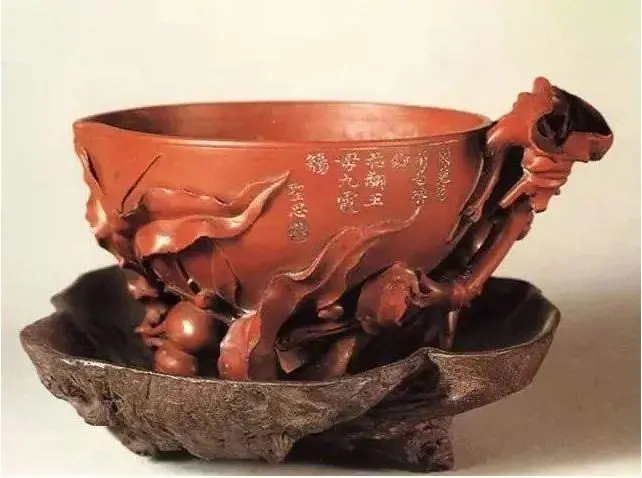
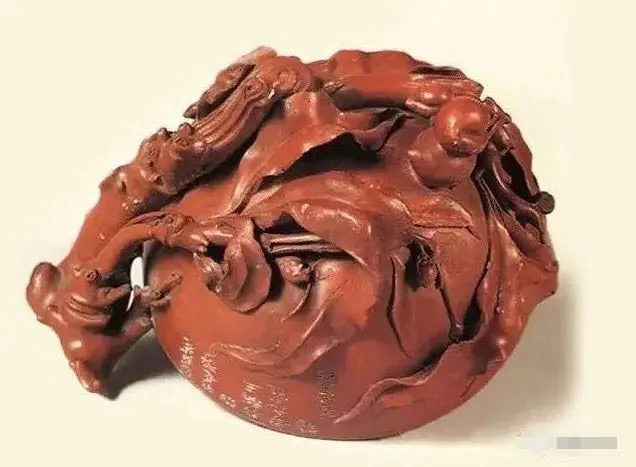
The Classic Yixing Teapots of the Qing Dynasty
12. Lujun Glaze Purple Clay Hanfang Teapot(炉钧釉大汉方)
The Lujun Glaze Purple Clay Hanfang Teapot is made with purple clay as its base material, and its surface is fully covered with Lujun glaze. The teapot has a flat square shape, and the handle is attached to three-fourths of the teapot body, forming a square handle with a bridge-style knob. At one-fourth of the teapot body, there is a decorative cloud pattern. The teapot’s design is powerful, dignified, and has a thick and rich glaze color. Both the glaze color and the design represent typical styles of the Qing Kangxi and Qianlong periods.
Representative Artisan: Hua Fengxiang, active during the Kangxi and Yongzheng periods of the Qing Dynasty. He excelled at imitating ancient styles and produced teapots that were elegant yet retaining an antique charm. He was also skilled in making purple clay stoves. His imitations of Hanfang-style teapots were exceptionally exquisite.
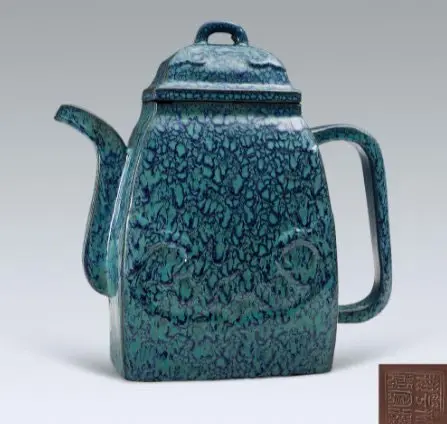
13. Mingyuan Sifang Teapot(鸣远四方壶)
The Mingyuan Sifang Teapot creatively combines straight and rigid lines with gentle and curved lines. It exudes both the dignified and noble aura of ancient times and the vibrant energy of the contemporary era. The teapot’s overall design is solid and upright, displaying a sense of robustness and gracefulness. The dynamic shape reflects a full and simple elegance.
Representative Artisan: Chen Mingyuan, from the Kangxi and Yongzheng periods of the Qing Dynasty, was a renowned purple clay teapot artist from Yixing. Born into a family of purple clay craftsmen, his father, Chen Ziqi, was also a skilled teapot maker during the Ming Dynasty. Chen Mingyuan learned from his father and was fearless in exploring new artistic directions. He excelled at crafting teapots that resembled natural objects such as tea pots, pen holders, or other vessels, capturing their essence with lifelike precision. He was praised as the “First Family of the Qing Dynasty,” and his works were often chosen as tribute to the imperial court.

Chen Mingyuan’s classic Zisha pots are particularly numerous, and a few of the most classic ones are appreciated below.





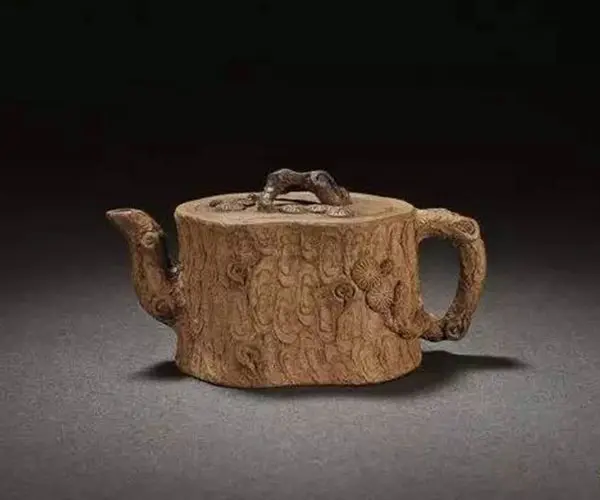
14. Bianyuan Teapot(扁圆壶)
The Bianyuan Teapot has a straight neck, flat and round abdomen, flat base, short and curved spout, and a curved handle. The teapot has a plain and unadorned surface, displaying a well-proportioned and dignified design. The exquisite craftsmanship fully showcases the natural beauty of the palace’s purple clay ware.
Representative Artisan: Xu Longwen, a master teapot artist from Yixing during the late Ming to early Qing Dynasty, and a disciple of Xu Youquan. Although not many of his teapots have been passed down, he was highly regarded by collectors from Japan even during the early Qing Dynasty, nearly 300 years ago.
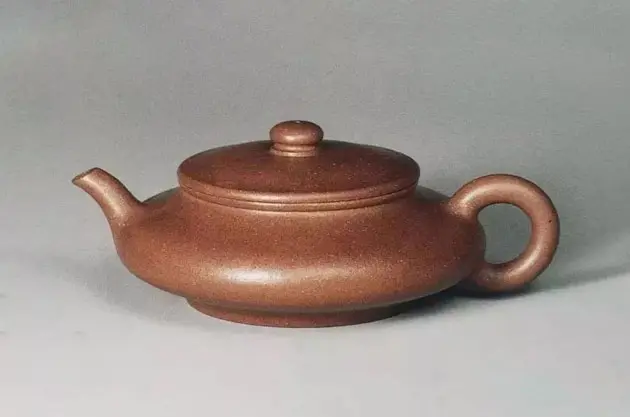
15. Liufang Teapot(六方壶)
The Liufang Teapot is made by assembling fourteen evenly cut clay pieces, forming a harmonious and balanced structure. The teapot has a gracefully upward-curved spout, smooth square handles, a large and flat lid, and a six-sided knob. The feet of the teapot also have six sides.
Representative Artisan: Hui Yigong (approximately 1766-1831), a famous purple clay artist of the Qing Dynasty. Hui Yigong lived during the late Qing Dynasty’s Yongzheng and Qianlong periods. He was a master at crafting both small and large teapots, and he was especially skilled at making small teapots. His works were praised for their craftsmanship and were considered on par with those of Hui Mengchen.
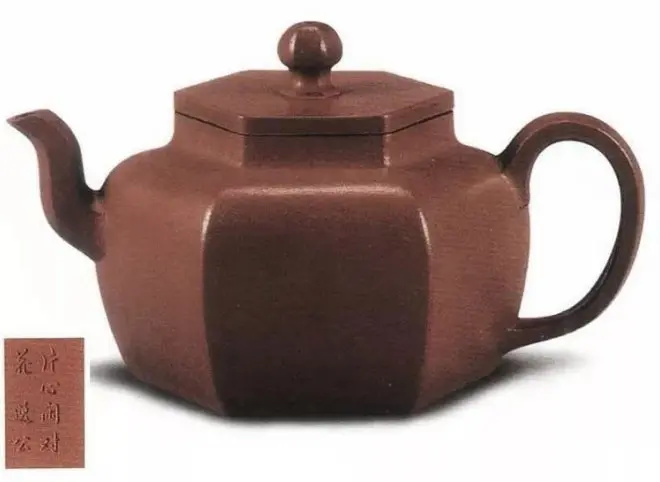
16. Man Sheng Eighteen Forms(曼生十八式)
The Man Sheng Eighteen Forms are renowned for their concise and lively shapes, profound and timeless inscriptions, as well as calligraphy and seal carving. The layout and composition on the teapot body have earned them great fame. These teapots elevated purple clay ware to become an excellent medium that combines various cultural elements. As a result, they are considered pure works of art and treasured in the world of purple clay.
Although they are called the “Eighteen Forms,” this is a general term for the Man Sheng teapots. Based on the known Man Sheng artifacts, it is clear that there are more than just eighteen of them.
Representative Artisan: Chen Hongshou (Man Sheng), a painter, calligrapher, and seal carver during the Qing Dynasty from the Qianlong to Daoguang eras. He hailed from Hangzhou, Zhejiang Province. In addition to his achievements in painting and calligraphy, Chen Hongshou was widely acclaimed for his design of purple clay teapots, earning him the title of “Pioneer of Scholar’s Teapots.” He employed skilled teapot craftsmen of that time, such as Yang Pengnian and the siblings Yang Fengnian, to make the teapots, while he inscribed the inscriptions on the teapot bodies, showcasing a distinctive scholarly charm.
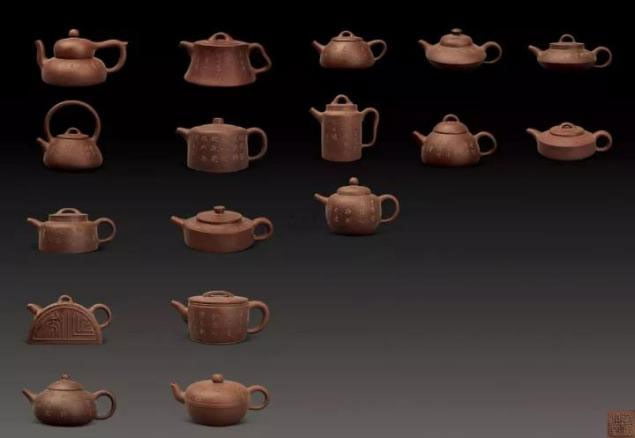
17. Wind Curled Sunflower Teapot(风卷葵)
The Wind Curled Sunflower teapot takes the shape of a curled sunflower, capturing both its physical form and lively spirit. The style of this teapot is inspired by the design created by Da Heng, featuring regular patterns, exquisite craftsmanship, an antique style with proper proportions, and a rich artistic flavor.
Representative Artisan: Yang Fengnian, a renowned teapot maker during the Jiaqing era of the Qing Dynasty, hailed from Jingxi, and some sources mention Tongxiang, Zhejiang Province. She was the sister of Yang Pengnian, a prominent purple clay master of the mid-Qing period. The Yang family, including Pengnian, Baonian, and Fengnian, excelled in the craft of teapot making. Yang Fengnian is the only female teapot artisan known by name in history.
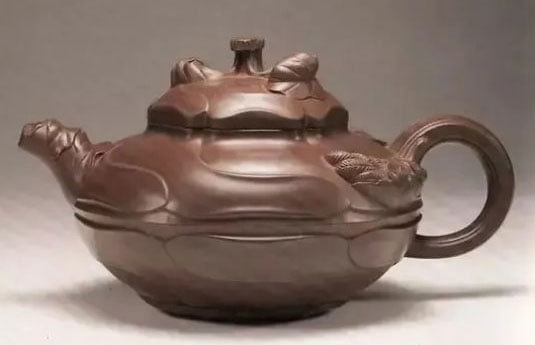
18. Ziye Shi Piao(子冶石瓢)
The Ziye Shi Piao teapot has a “pyramid” shaped body, narrower at the top and wider at the bottom, with a lower center of gravity for better stability. It features a straight spout, a triangular handle, a bridge-shaped knob, and is supported by three flattened round feet. The overall design is simple and grand, exuding a sense of strength unlike the elegant and steadfast style of Man Sheng-style stone gourd teapots.
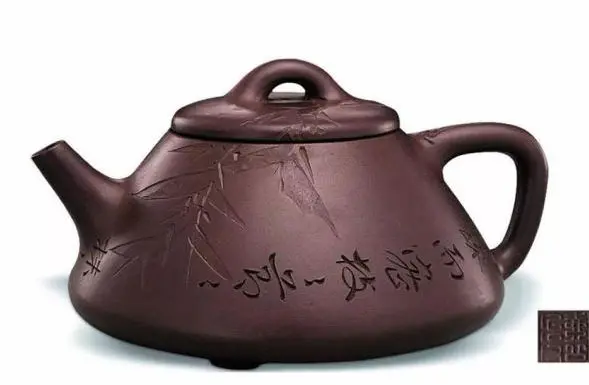
Representative Artisan: Qu Yingshao (Ziye), a native of Songjiang, Shanghai. His business was called “Yuxiu Tang.” He was a master of calligraphy, seal carving, and purple clay pottery during the Qing Dynasty, known for his excellent poetry and prose.
Qu Yingshao designed and made numerous teapots throughout his life. He often imitated Chen Mansheng, collaborated with renowned teapot maker Yang Pengnian, and painted bamboo and inscribed poems on the teapots, while his friend Deng Kui (Fu Sheng) carved the seals. In his later years, he created the “Moon Teapot” and was known as the “Qu Teapot.” Unfortunately, his teapot-making techniques were not passed down to future generations.
Like Mansheng, Ziye made significant contributions to the art of purple clay teapot making. However, Ziye’s contributions were mainly in the field of engraving and painting. This classic teapot style has been passed down through the years, and many artisans are skilled in its creation, especially in carving bamboo patterns, combined patterns of bamboo branches, and plum blossoms.
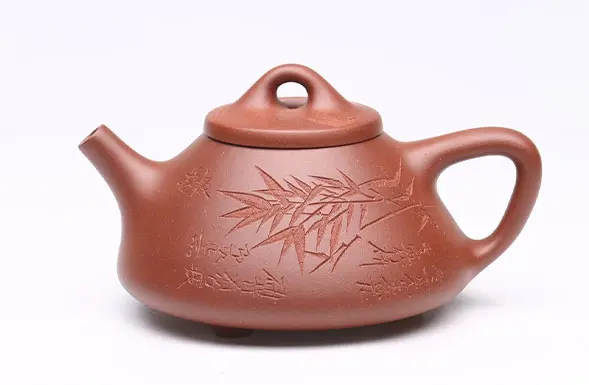
19. De Zhong Teapot(德钟壶)
The De Zhong Teapot features an elegant and dignified shape, harmonious proportions, and a rigorous structure, making it one of the classic teapot styles. The clay used for this teapot has a chestnut color, displaying a pure and lustrous purple tone. The entire teapot feels exceptionally smooth to the touch, as if caressing a baby’s skin. It bears the signature mark of “Da Heng.”
Representative Artisan: Shao Daheng, a renowned teapot maker from Yixing during the Daoguang and Xianfeng eras of the Qing Dynasty. He gained fame from a young age and became a master craftsman following in the footsteps of Chen Mingyuan. His teapots were known for their expressive style, especially in creating simple and concise forms that emphasized the pure and elegant artistic essence of purple clay. In the Qing Dynasty, his teapots were already considered treasures by tea enthusiasts and collectors.

20. Flat Lid Lotus Seed Teapot(平盖莲子壶)
The Flat Lid Lotus Seed Teapot takes inspiration from the lotus seed, the fruit of the lotus flower, and its design originates from the popular lotus seed jars among the common people during the Chongzhen era of the Ming Dynasty. The teapot has a flat cylindrical body with a leveled shoulder, a tapered spout, and a round lid that fits snugly onto the teapot mouth, ensuring excellent airtightness. The lid is adorned with a delicate bridge-shaped knob, making it convenient to hold, while the elegant spout allows for a smooth pouring experience. The handle is slender and graceful.
Representative Artisan: Zhao Songting, also known as Dongxi, was an outstanding purple clay pottery artist during the Qing Dynasty from the Daoguang to the Xianfeng eras. He was also highly accomplished in painting and calligraphy. His carved purple clay teapots integrated “poetry, calligraphy, painting, and seals” into a harmonious whole, reaching a high level of artistic expression.
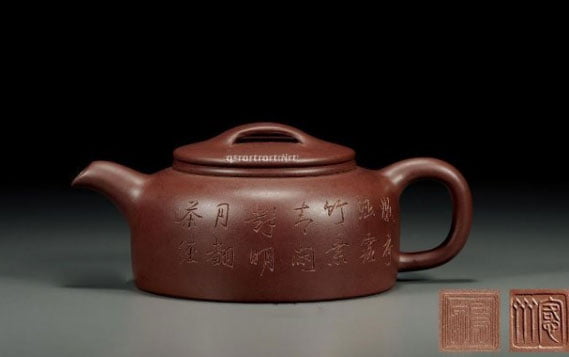
21. Xin Zhou Shi Piao(心舟石瓢)
The Xin Zhou Shi Piao has a smooth and natural curve, giving it a stable and elegant appearance. Unlike the previous Man Sheng Shi Piao and Ziye Shi Piao, the Xin Zhou Shi Piao seamlessly combines design, production, calligraphy, and seal carving.
Representative Artisan: He Xin Zhou, a renowned teapot maker from the Qing Dynasty, known for his skill in crafting purple clay teapots from the Dao Guang to Tongzhi eras. He collaborated with Wang Dong Shi to establish the Yu Cheng Kiln in Ningbo, Zhejiang Province, which produced exceptional teapots with a distinct literati flavor.
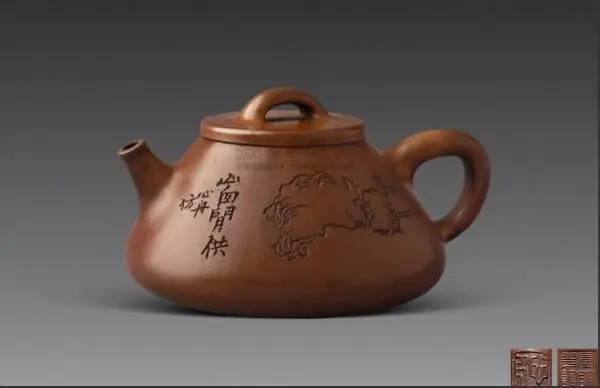
22. Shi Qiu Hu (Lion Ball Teapot)狮球壶
The Lion Ball Teapot is characterized by its knob, which is sculpted in the shape of a reclining lion holding a embroidered ball. The teapot has a simple and clean design, with a clear theme when used for tea tasting and appreciation.
Representative Artisan: Jiang An Qing, a skilled purple clay artisan from the late Qing Dynasty to the early Republican era. Known for his simple craftsmanship, he worked as a technician making teapots for the Yang Xian Purple Clay Pottery Industry Company in Shushan, Yixing in 1912. His Lion Ball Teapot was also exhibited at the Nanyang Industrial Exposition and won an award at the 1915 Panama-Pacific International Exposition in the United States.

23. Guang Ming Shi Piao(光明石瓢)
The Guang Ming Shi Piao has a trapezoidal body with smooth and gentle curves, giving it a solid and rustic appearance. The tripod feet provide a sense of lightness and stability, while the straight spout and triangular handle complement the overall design, creating a harmonious visual effect. The flat lid and bridge-shaped knob are proportionate, showcasing exquisite craftsmanship.
Representative Artisan: Chen Guang Ming, also known as Zhao Kuang Lu, Zhao Run Bao, was an accomplished purple clay artist from Yixing, Jiangsu Province, active during the late Qing Dynasty and early Republican era. He excelled in crafting delicate and exquisite purple clay wares, known for their roundness, refined workmanship, and natural elegance. Unfortunately, very few of his teapots have survived to this day.
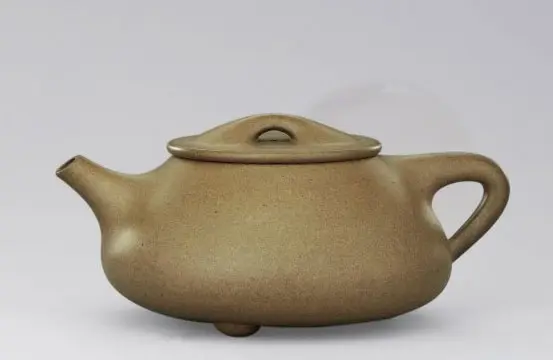
24. Yu Hua Long Teapot(Fish Transforming into Dragon)鱼化龙壶
The Yu Hua Long teapot features a clever design where the decorative elements of fish, dragon, and clouds are seamlessly integrated into the teapot body. The entire teapot is adorned with wave-like patterns, with smooth and concise lines, and a lively depiction of the fish and dragon. The lid, in the shape of a dragon head, is flexible and elegant, complemented by a dragon tail as the handle, adding a touch of whimsy.
Representative Artisan: Huang Yu Lin, a renowned teapot maker born in the late Qing Dynasty (1842-1914), and an important figure in teapot making following Shao Da Heng. His teapots were known for their meticulous selection of clay, exquisite craftsmanship, and natural artistic charm. It is said that he devoted great care and time to each teapot, achieving a high level of refinement and craftsmanship.

25. Duo Qiu Hu (Ball Scoop Teapot)掇球壶
The Duo Qiu Hu, when viewed as a whole, may not resemble a ball, but upon closer examination, every part of it is derived from the concept of a ball. The body of the teapot is a large sphere, the lid is a half-sphere, the knob on the lid is another sphere, and the spout and handle are derived from a curved section of the sphere. While it may seem odd to combine these different spherical elements, purple clay artists skillfully transform and modify them to create a sense of beauty and harmony.
Representative Artisan: Cheng Shou Zhen, also known as Chen Shou Zhen and with the pseudonym Bing Xin Dao Ren, was an artist from Yixing, active from the late Qing Dynasty to the early Republican period. He was a student of Shao You Ting and excelled in creating teapots with concise and elegant forms. His most famous creation, the Duo Qiu Hu, won gold awards at the 1915 Panama-Pacific International Exposition and the Chicago World’s Fair.

26. Si Fang Chuan Lu (Square Stove Teapot)四方传炉
The Si Fang Chuan Lu, when viewed from the side, has a rounded body, but when viewed from above, it appears square, symbolizing the union of heaven and earth. The short and thick teapot spout, along with the round handle and square four feet, resemble a tripod. Compared to typical square vessels, it has a rounded and pleasing aesthetic.
Representative Artisan: Yu Guo Liang, a master teapot maker from Yixing during the late Qing Dynasty and early Republican era. Originally from Wuxi, Jiangsu Province, his teapots were known for their meticulous craftsmanship and balanced design. His teapots appeared naturally perfect, as if created by nature itself, and he won the Outstanding Award at the 1932 Chicago World’s Fair.
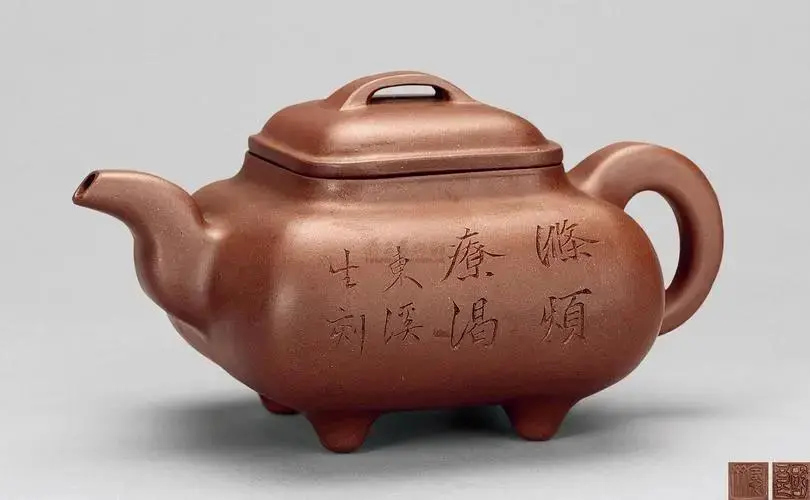
Modern Classic Yixing Teapots
27. Barrel Yixing Teapot(洋桶壶)
The Barrel Yixing Teapot, a popular teapot style, was once sold in Thailand and Malaysia. Its long, round shape is elegant and dignified, showcasing typical commercial features. Adorned with a beautiful copper handle, it exhibits exquisite decoration that reflects local customs and traditions. The Barrel Teapot is not only suitable for beginners to practice their skills but also serves as a test of their mastery of traditional purple clay techniques.
Representative Artisan: Ren Ganting (1888.8-1969.12), a native of Yixing, Jiangsu Province, China, was one of the “Seven Old Masters” of purple clay teapots. Ren excelled in various calligraphic styles, particularly in seal script and clerical script. One of his extraordinary skills was simultaneously carving symmetrical patterns with both hands. This unique technique emerged from his ambidextrous nature as a left-handed person who, during his employment at the pottery workshop of Wu Desheng, honed his skills in right-handed clay carving.
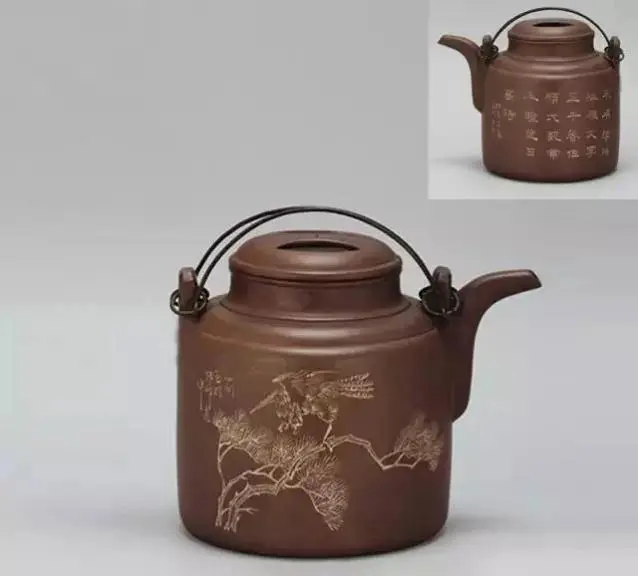
28. Fish Trap Yixing Teapot(鱼罩壶)
The Fish Trap Yixing Teapot, created by Pei Shimin, derives its name from its resemblance to a fishing net trap. Moreover, its design ensures stable placement. The teapot features a flat shoulder, tall neck, sloping shoulder, arch-shaped knob, flat lid, straight spout, and square-shaped handle. Its overall design is simple, lively, sturdy, and elegant, with a distinctive and innovative personality.
Representative Artisan: Pei Shimin (1892-1976), a resident of Shushan, Yixing, was a renowned purple clay artist. He initially studied purple clay teapot making under the guidance of Jiang Zuchen, a master of the craft during the late Qing Dynasty and early Republican period. After achieving mastery, Pei excelled in producing antique-style purple clay wares, garnering great acclaim. He was adept at crafting water containers, cup trays, and incense burners, characterized by their elegant and unique designs, reminiscent of the solid and stately qualities of bronze vessels. Among his works, his realistic fruit-shaped teapots earned him the title of “Chen Mingyuan’s Second.”

29. Twisted Bamboo Handle Teapot(绞竹提梁)
The Twisted Bamboo Handle, an innovation by Wu Yungen, incorporates two bamboo twigs twisted together for the teapot handle. This technique enhances the strength of the handle while maintaining a streamlined appearance. The bamboo leaves attached to the teapot lid add a subtle touch.
Representative Artisan: Wu Yungen (1892-1969), who lived through three different eras, from the late Qing Dynasty to the Republic of China, and through the resistance against Japanese aggression, experienced numerous hardships and challenges. Born into a financially struggling family at the end of the Qing Dynasty, Wu began his apprenticeship at the age of fourteen under the tutelage of Wang Shengyi. Wang was skilled in creating both plain and bamboo-adorned purple clay wares, and Wu Yungen learned from him diligently, establishing a solid foundation of skills.
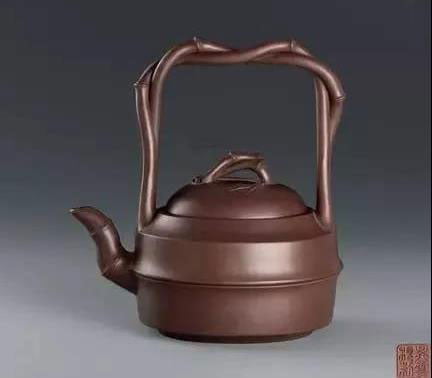
30. Plum Blossom Rhythm Teapot(梅花周盘)
The Plum Blossom Rhythm teapot was pioneered by Wang Yinchun. Its body, lid, and knob are adorned with the motif of interlocking veins and diamond-shaped plum blossoms, creating a harmonious and meticulously arranged design that showcases the artist’s craftsmanship. The teapot gained immediate popularity upon its introduction.
Representative Artisan: Wang Yinchun (1897-1977), originally from Zhenjiang, Jiangsu Province, China, was one of the “Seven Old Masters” of purple clay teapots. He initially studied under Zhao Songting and later became a disciple of Jin Ashou. Wang developed a unique style characterized by disciplined and robust plain clay wares and graceful and exquisite vein pattern wares, which few could rival. He was renowned for his ability to produce a large quantity of high-quality teapots quickly.
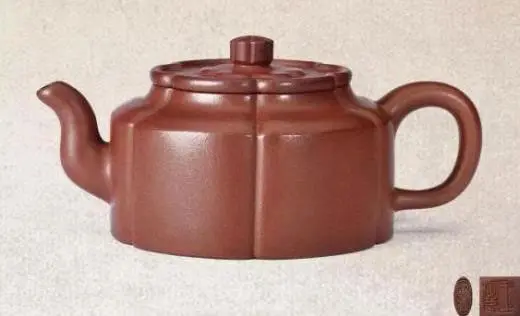
31. Three Friends in the Cold of Winter Teapot(岁寒三友壶)
The Three Friends(Pine, bamboo, plum) in the Cold of Winter teapot showcases exceptional craftsmanship in its lifelike details. The teapot’s body is not a simple cylindrical shape but rather derived from a section of bamboo root. The bottom of the teapot features a ring-shaped indentation from the removed bamboo root, with a sturdy segment of bamboo root supporting the entire teapot. The selection of clay colors, arrangement of the three friends (pine, bamboo, and plum), and the coordination between the spout and handle all require careful consideration.
Representative Artisan: Zhu Kexin (1904-1986), originally named Zhu Kaichang and known by the artistic name “Kexin,” which conveys the meaning of “those who are humble can learn” and “a cup of water in the mountains can purify one’s heart.” At the age of fourteen, he became a disciple of Wang Shengyi and formed a close friendship with Wu Yungen.
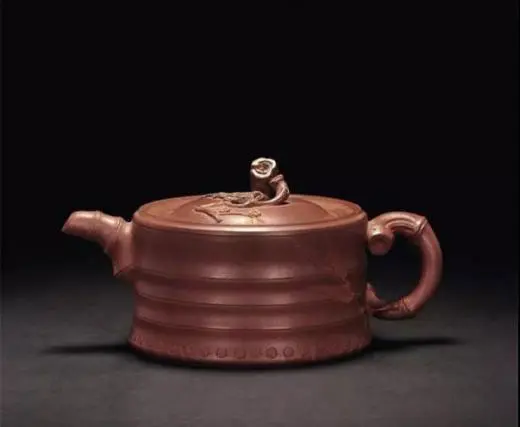

32. Xiao Ying Teapot(笑樱壶)
The Xiao Ying Teapot has a slightly flattened round body that gradually converges to a circular foot, giving it a sense of stability. The shoulder has a decorative ring, which complements the mouth and lid edges, creating a harmonious “three-line” design. Overall, the teapot has a simple and full-bodied shape with smooth lines, meticulous craftsmanship, and a sense of openness and elegance.
Representative Artisan: Gu Jingzhou (1915-1996). He began his apprenticeship at the age of 18 and in the late 1930s, he imitated antique teapots in Shanghai. In 1954, he joined the Shushan Ceramic Cooperative in Yixing, and in 1956, he was appointed as a technical advisor by the Jiangsu Provincial Government, mentoring Xu Hantang, Gao Haigeng, Li Changhong, Shen Juhua, Shu Fengying, Wu Qunxiang, and others.
Gu Jingzhou excelled in creating simple teapots, and each piece was carefully crafted, resulting in exquisite works of art. He participated in the National Arts and Crafts Representatives Conference three times in his lifetime and had a significant influence in Hong Kong, Macau, Taiwan, and Southeast Asia, earning him the reputation of a “master of teapot art” both domestically and internationally.
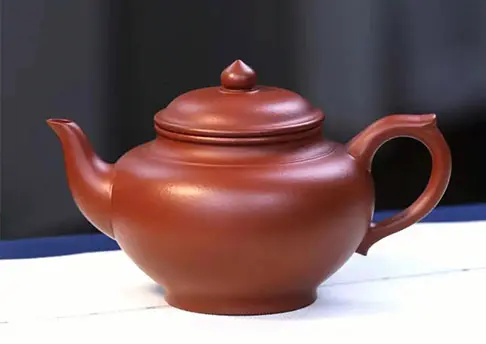
33. Nine-Piece Lotus Flower Tea Set(九件荷花套组)
The Nine-piece Lotus Flower Tea Set was pioneered by Jiang Rong. The teapot features a lotus flower-shaped body, a lotus seed pod as the lid, and a flower stalk as the handle, creatively using colored purple clay. The teapot has a beige base color, with crimson flower veins, dark green lotus chambers, translucent green lotus leaves, and a vibrant green frog. The teapot stands on red diamond-shaped feet and white lotus roots. The color decoration is natural and refreshing, showcasing its beauty.
Representative Artisan: Jiang Rong (1919-2008), also known as Lin Feng, was from Chenbu, Qianluo, Yixing City, Jiangsu Province. In 1995, she was honored with the title of “Chinese Master of Arts and Crafts.” Jiang Rong’s works have received the “Special Prize” at the National Industrial Conference and have been presented as gifts during Prime Minister Zhou Enlai’s visits to Southeast Asian countries.
Jiang Rong is renowned in the history of Chinese purple clay craftsmanship for her exquisite technique, vivid and authentic creations, and unique style. She is also the first female Master of Arts and Crafts in the history of Chinese purple clay craftsmanship.

Conclusion
In summary, there are thousands of different shapes of purple clay teapots in the market, and to appreciate them, we need to learn more about purple clay teapot knowledge. We should appreciate them from the perspective of culture, trace their authenticity, understand how they have been innovated by famous artists, and determine if the innovations are reasonable. By understanding the symbolism and unique characteristics left by the artisans on the teapots, we can truly appreciate the classics and distinguish and appreciate their value.
Furthermore, when buying teapots, some people spend a few hundred yuan, some spend a few thousand yuan, and some spend tens of thousands. Is it worth the price? After learning how to appreciate them correctly, it can also serve as a reference and save us from making mistakes.
